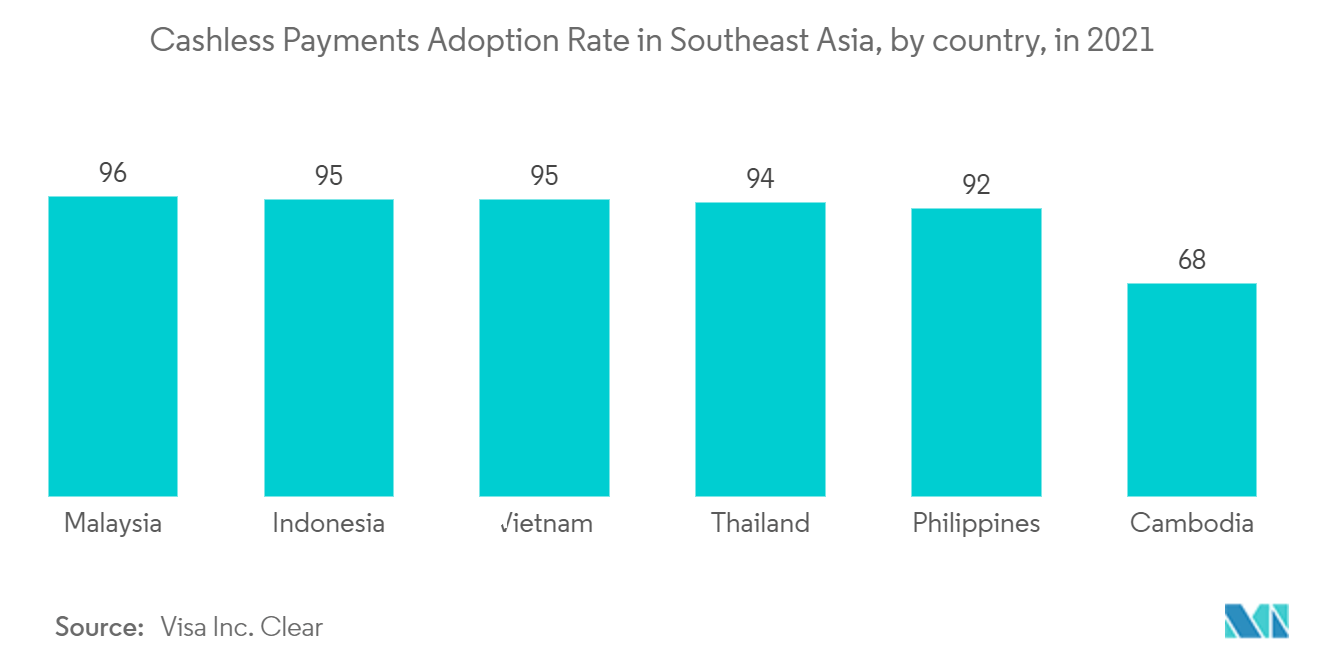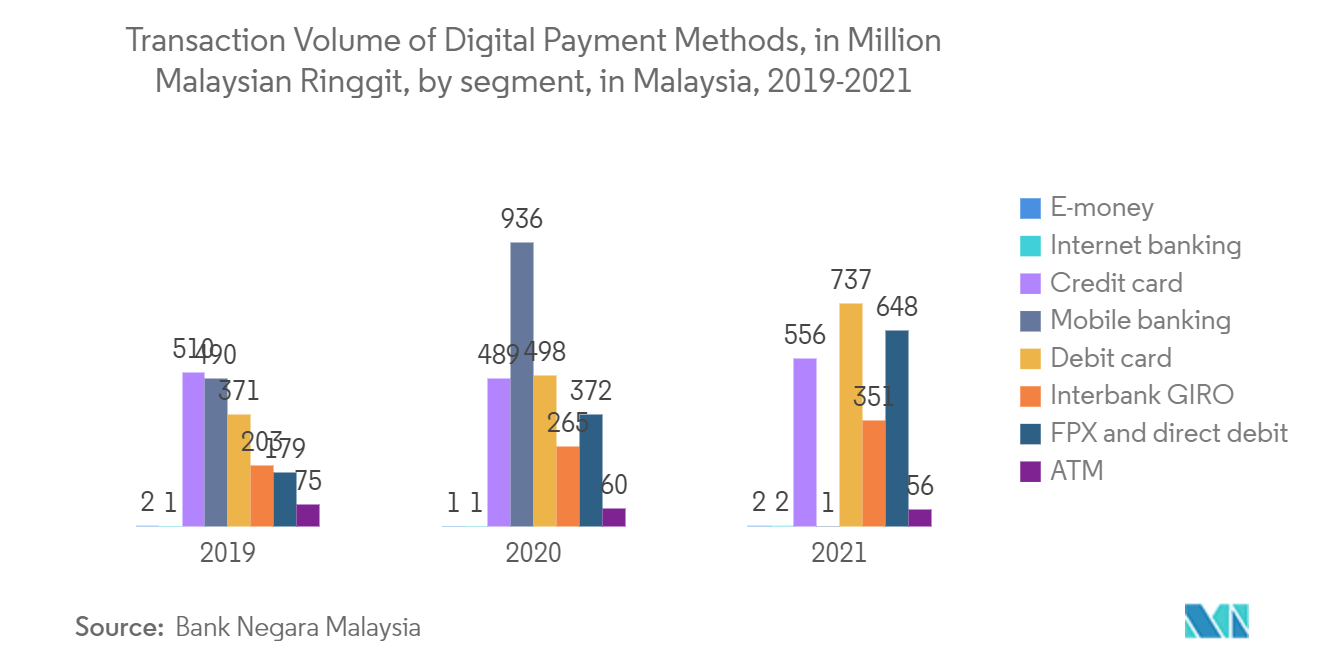Market Trends of Asia-Pacific Payments Industry
Online sales segment to show higher growth
- The mobile payment landscape across Asia is changing due to digital transformation. Also, the technological developments in the smartphone have enabled e-commerce payments and on-the-go fund transfers, fueling the global market growth. Mobile payment platforms like Tencent, based in China, have grown rapidly. Tencent also expanded in other Asian countries, like Thailand, and it is searching for major partners to help it localize its services.
- The most common payment medium is projecting QR codes at the shop, wherein small-scale local shops also accept mobile payments. As China and India have been leading in this form of payment, countries like Japan are slowly introducing initiatives to promote QR code-based payments due to the government's aim to double cashless transactions to JPY 120 trillion (90 Billion USD) in 2025.
- The consumer preference toward digital payment methods indicates the increasing use of contactless payment modes. For instance, in the current year, Worldline, a provider of payment services, teamed up with Casio, a business with its headquarters in Japan, to enable card payments and cashless shopping in Japan. Offering this service in Japan will support efforts to change that country's more traditional retail environment. This will also involve Vesca, a regional payment solution supplier, focusing on a large Japanese market primarily of small business retailers.
- The rise of e-commerce and the O2O market has created many scenarios for people to adopt mobile payments in recent years. According to WorldPay, digital/mobile wallet is expected to occupy 60.2% of e-commerce payments in 2024 in Asia-Pacific, followed by credit card (16.1%). On the other hand, mobile payment was crucial in reducing friction and making on-demand, small-ticket services easily adoptable when they first emerged in the region. Rapid developments in these sectors, in turn, further drive the uptake in mobile payment usage.
- Further, the e-commerce sector in retail businesses is witnessing a spike in demand as consumers order essential items such as food and clothes, among others, through e-commerce websites, where most consumers prefer the digital mode of payment. According to a survey of cross-border e-commerce enterprises last year, PayPal was the dominant digital payment platform in the Philippines, with 74% of the enterprises using it.
- According to RBI, the digital payments index (DPI), launched in January of last year to indicate the extent of digitization of payments in India, the index for September of the same year stood at 304.06 against 270.59 in March. This shows the rapid adoption and deepening of digital payments across the country.

Malaysia is Expected to hold Major Market Share of the Market
- Payment systems are an essential component of a country's economic infrastructure. The Bank Negara Malaysia-owned Payments Network Malaysia Sdn Bhd (PayNet), a payment subsidiary, operates Malaysia's extensive value payment system, RENTAS, which permits the transfer and settlement of high-value interbank payments and securities. Its failure could trigger a systemic crisis and send shockwaves through the financial system. With RENTAS's effective operation, transactions may be completed securely and promptly, boosting economic performance. According to Bank Negara Malaysia, the overall transaction value for digital payment methods in Malaysia last year, including e-money, online banking, FPX, and mobile internet, was RM 7.9 Billion (1.71 Billion USD). Total transaction value increased by 1.9 billion Malaysian ringgit over the previous year.
- Payment systems that are secure and effective are essential for promoting financial stability as they make it simpler for Bank Negara Malaysia to carry out its monetary policy by allowing it to use more market-based instruments to accomplish its goals while also improving the effectiveness of the financial system and the economy. Given its significance, one of the bank's primary foundations is promoting a reliable, efficient, and secure payment system.
- Furthermore, COVID-19 resulted in a significant boost in demand for digital payments in the country. Malaysia has achieved substantial progress in financial inclusion in recent years, owing to favorable policies, innovation, and a growing banking sector. Recently, in April of the current year, Bank Negara Malaysia (BNM) announced five successful applications for digital bank licenses, which Malaysia's Minister approved Finance. The applicants will undergo operational preparedness following this announcement, which BNM will verify through an audit before commencing operations. BNM is expected to continue collaborating with the financial and fintech sectors and key stakeholders through the five strategic thrusts outlined in the Financial Sector Blueprint 2022-2026 to continuously improve access to financial services nationwide and among all societal segments.
- As Malaysia moves closer to becoming a cashless society and digital payments become more widely used, market providers are improving their payment options to help shops and merchants position themselves for the future of commerce and meet customer expectations. However, small businesses continue to rely heavily on cash transactions. Getting cashless will also be difficult for certain small businesses, and street vendors need help acquiring the equipment to keep their digital currency.
- The growing collaborations and partnerships to meet the growing demand for payments in the country are the key factors contributing to the market growth rate. For instance, in September of the year, Ingenico, a Worldline Brand, and Paysys(M) Sdn Bhd, a wholly owned subsidiary of GHL Systems Bhd, announced merging their commercial competencies to address the Malaysian payment market. Ingenico will likely sell some of its client and business assets to GHL in Malaysia as part of this deal. By developing this new operating model, Ingenico will strengthen its position in Malaysia by utilizing Paysys' in-depth understanding of the market and bringing Ingenico's wide array of payment solutions to open new opportunities with more clients and unlock new payment experiences.


